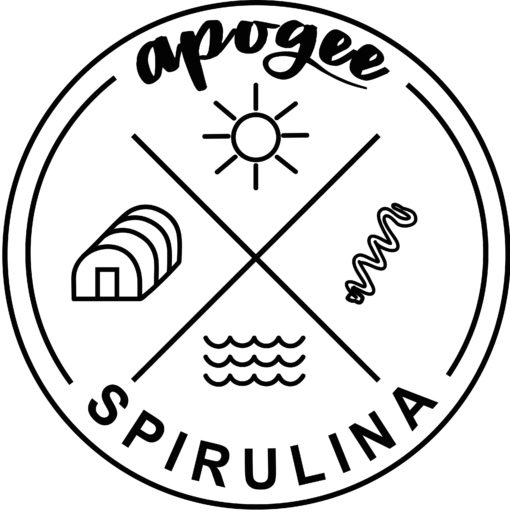Spirulina is life
Billions of years old and sometimes (mis)classified as a plant, Spirulina is actually a blue-green algae now known as a cyanobacteria. One of the first organisms to harness the sun’s light and convert atmospheric carbon dioxide (CO2) into oxygen (via photosynthesis), spirulina is also classified as a microalgae.
One of the thousands of varieties of algae covering the planet, spirulina grows naturally in alkaline lakes, thrives in dry, hot climates, and has qualities that evolved into elements essential to both plants (chlorophyll-A) and animals (hemoglobin—red blood cells).
Protein rich (3 grams of dried spirulina contains 2 grams of protein), spirulina also boasts decent amounts of Vitamins B1, B2, B3, copper, iron, magnesium, potassium, calcium, niacin, and manganese, as well as small amounts of omega-6 and omega-3 fatty acids and all the essential amino acids.
It’s also a superfood—a marketing term that has no basis in nutritional fact, nevertheless, the label has come to stick, especially to nutrient-rich foods that have a positive impact on people’s health. And spirulina has many, many health benefits.
Even so, as superfoody as it is, the Food & Drug Administration has yet to sign off on its many applications (except as a food coloring—in things like candy and chewing gum). That’s mainly because there haven’t yet been enough studies proving its many benefits—and the ones that have shown positive results have not had enough participants to earn them FDA credibility.
Similarly, although the National Institutes of Health hasn’t signed off on spirulina yet either, they have acknowledged that spirulina seems to have helped with premenstrual symptoms and amyotrophic lateral sclerosis (Lou Gehrig’s disease). Despite the lack of scientific evidence so far, in 1992 the World Health Organization declared spirulina as the “best food for the future,” and the most nutritionally complete source of food for the 21st Century. A decree that echoed the statement issued by UNIDO, the United Nations Industrial Development Organization, in 1980, in which the United Nations arm stated that “spirulina will become an excellent food in the future.”
So. Among the many things that spirulina may do:
• It may serve as a chelation supplement—detoxing the body of heavy metals
• It may improve your endurance and muscle strength and recovery
• It may improve your microbiome (gut)
• It may reduce blood pressure
• It may improve the immune system and improve kidney and liver function
• It may help be helpful in treating diabetes
• It may help keep your blood sugar levels under control
• It may eliminate candida
• It may lower the so-called bad cholesterol (your LDL and triglyceride levels
• It may be helpful in combating cancer
• It may be helpful against anemia
• It may help treat depression, anxiety, stress, and attention deficit-hyperactivity disorder (ADHD)
However, it may also lead to certain autoimmune reactions in some people, especially those who are already susceptible to autoimmunity. Which is why pregnant women and children need to take it with caution. And because it might contain the amino acid phenylalanine, it should be avoided by people who have phenylketonuria (PKU) — a metabolic disorder in which the body can’t metabolize phenylalanine.
Despite being around for eons, Spirulina as a commercial product didn’t come into existence until the 1970s. That’s when a company in Mexico opened the first large-scale spirulina production plant. By the 1980s people were onto it—though slowly, as that was also the era of soy protein and tofu. And then, after a health scare, spirulina disappeared again, going underground for another couple of decades. And then reemerged about ten years ago, as the French, once again, reembraced spirulina and how to harvest it safely and effectively.
Spirulina is life
Billions of years old and sometimes (mis)classified as a plant, Spirulina is actually a blue-green algae now known as a cyanobacteria. One of the first organisms to harness the sun’s light and convert atmospheric carbon dioxide (CO2) into oxygen (via photosynthesis), spirulina is also classified as a microalgae.
One of the thousands of varieties of algae covering the planet, spirulina grows naturally in alkaline lakes, thrives in dry, hot climates, and has qualities that evolved into elements essential to both plants (chlorophyll-A) and animals (hemoglobin—red blood cells).
Protein rich (3 grams of dried spirulina contains 2 grams of protein), spirulina also boasts decent amounts of Vitamins B1, B2, B3, copper, iron, magnesium, potassium, calcium, niacin, and manganese, as well as small amounts of omega-6 and omega-3 fatty acids and all the essential amino acids.
It’s also a superfood—a marketing term that has no basis in nutritional fact, nevertheless, the label has come to stick, especially to nutrient-rich foods that have a positive impact on people’s health. And spirulina has many, many health benefits.
Even so, as superfoody as it is, the Food & Drug Administration has yet to sign off on its many applications (except as a food coloring—in things like candy and chewing gum). That’s mainly because there haven’t yet been enough studies proving its many benefits—and the ones that have shown positive results have not had enough participants to earn them FDA credibility.
Similarly, although the National Institutes of Health hasn’t signed off on spirulina yet either, they have acknowledged that spirulina seems to have helped with premenstrual symptoms and amyotrophic lateral sclerosis (Lou Gehrig’s disease). Despite the lack of scientific evidence so far, in 1992 the World Health Organization declared spirulina as the “best food for the future,” and the most nutritionally complete source of food for the 21st Century. A decree that echoed the statement issued by UNIDO, the United Nations Industrial Development Organization, in 1980, in which the United Nations arm stated that “spirulina will become an excellent food in the future.”
So. Among the many things that spirulina may do:
• It may serve as a chelation supplement—detoxing the body of heavy metals
• It may improve your endurance and muscle strength and recovery
• It may improve your microbiome (gut)
• It may reduce blood pressure
• It may improve the immune system and improve kidney and liver function
• It may help be helpful in treating diabetes
• It may help keep your blood sugar levels under control
• It may eliminate candida
• It may lower the so-called bad cholesterol (your LDL and triglyceride levels
• It may be helpful in combating cancer
• It may be helpful against anemia
• It may help treat depression, anxiety, stress, and attention deficit-hyperactivity disorder (ADHD)
However, it may also lead to certain autoimmune reactions in some people, especially those who are already susceptible to autoimmunity. Which is why pregnant women and children need to take it with caution. And because it might contain the amino acid phenylalanine, it should be avoided by people who have phenylketonuria (PKU) — a metabolic disorder in which the body can’t metabolize phenylalanine.
Despite being around for eons, Spirulina as a commercial product didn’t come into existence until the 1970s. That’s when a company in Mexico opened the first large-scale spirulina production plant. By the 1980s people were onto it—though slowly, as that was also the era of soy protein and tofu. And then, after a health scare, spirulina disappeared again, going underground for another couple of decades. And then reemerged about ten years ago, as the French, once again, reembraced spirulina and how to harvest it safely and effectively.

